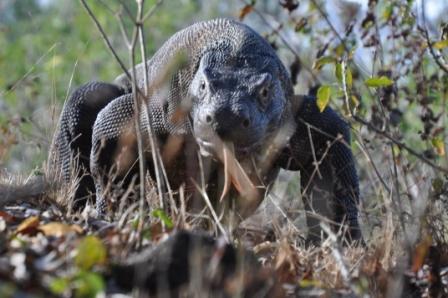Komodo Expedition
Pollyanna is often asked if she ever faces any dangerous situations while on her expeditions or working with wildlife – and indeed she has had one or two narrow escapes. But on this most recent journey she came face to face with one of the most potentially dangerous creatures she has ever studied – armed only with a stick.
Whilst in Indonesia Pollyanna visited several islands – not only Borneo in search of orang-utans – but also Java, Flores, Bali, and Rinca and Komodo, both of which are home to the legendary dragons. Pollyanna and Anna-Louise trekked in the National Park, in temperatures which reached 43ºC in order to come face to face with the world’s largest lizards in their natural habitat. Komodo Dragons can grow over 3m in length, and are armed with sharp claws and serrated teeth.

Their mouths drip with a reddish coloured deadly saliva which carries around 50 infectious agents, particularly bacteria. If prey manages to escape from the attack of a Komodo dragon the deadly bacteria in the lizard’s saliva will eventually kill it. The dragon follows the bitten prey at a leisurely pace and devours it after the animal succumbs to death. Although for years it has been believed that the Komodo’s victims mostly died from blood poisoning from this deadly cocktail, the latest studies on these reptiles have shed light on their equally fatal venom which is reported to lower blood pressure, hasten blood loss, and send the incapacitated animal into shock.
Komodo Dragons have powerful legs and can run at surprising speeds – covering short distances at speeds of 20 kph. They are good at climbing, and can even swim, so there is no escape in the water. They can consume prey which is more than 80% of their body weight. So what did Pollyanna do when she first came face to face with one of these cannibalistic giant lizards in the wild? Sat down with her sketch pad and started work of course!
Pollyanna and Anna-Louise were fortunate enough to see seven wild dragons during their expedition, as well as a dragons’ nest where the females lay their eggs. They then fiercely guard the eggs against predators for three months before abandoning them completely for a further six months, returning only to the nest site when they hatch. The Mothers will then happily feast on their own young – as will any other dragons in the area. For this reason, when the young dragons hatch, they immediately climb into the tops of trees which the adult dragons are too heavy to climb – and live there for around three years until they are large enough to defend themselves on the ground! Pollyanna and Anna-Louise were even fortunate enough to spot a baby dragon in the top of a tree – a very rare sighting.
The resulting paintings will be exhibited in Pollyanna’s private gallery in her 2016 Summer exhibition, which will be called Here Be dragons……..
While on Expedition in Indonesia Pollyanna also spent time in the Kalimantan region of Borneo to study orang-utans.
Did You Know…….
- Komodo dragons were discovered by the western world when a WWI pilot crash landed on one of the Islands and spotted these extraordinary creatures – native pearl fishermen had also reported seeing gigantic, prehistoric animals living on Komodo Island.
- Their tongue is forked, just like snakes. Komodo dragons make use of their tongue to smell any carrion in the vicinity. They can locate a food source even if it is as far as 4 km away.
- In the wild, there are about 4 times as many male Komodos as females
- There are several documented cases of humans becoming prey to these aggressive animals. In one case, a German tourist was mauled to death by Komodos. In another incident, a park ranger was attacked by a Komodo while he was doing some paperwork in his hut. The ranger narrowly survived after receiving some serious injuries.








